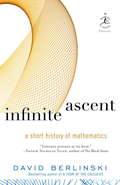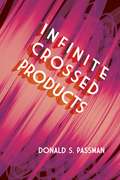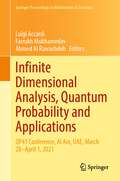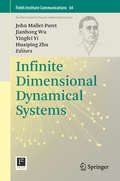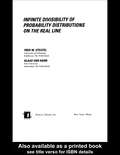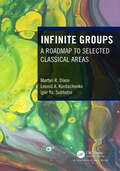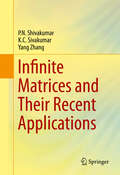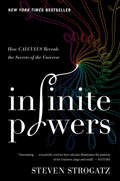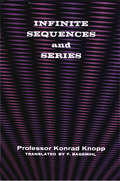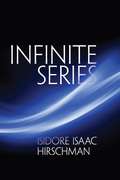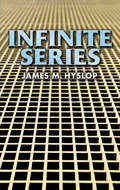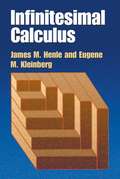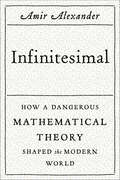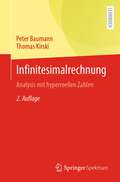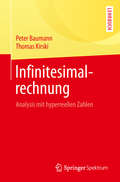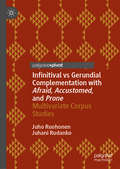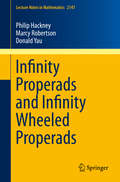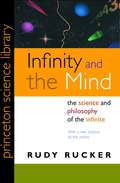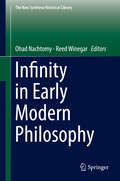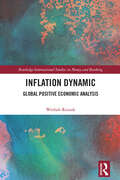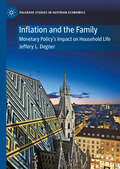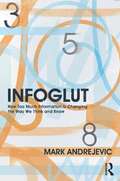- Table View
- List View
Infinite Ascent
by David BerlinskiIn Infinite Ascent, David Berlinski, the acclaimed author of The Advent of the Algorithm, A Tour of the Calculus, and Newton's Gift, tells the story of mathematics, bringing to life with wit, elegance, and deep insight a 2,500-year-long intellectual adventure.Berlinski focuses on the ten most important breakthroughs in mathematical history-and the men behind them. Here are Pythagoras, intoxicated by the mystical significance of numbers; Euclid, who gave the world the very idea of a proof; Leibniz and Newton, co-discoverers of the calculus; Cantor, master of the infinite; and Gödel, who in one magnificent proof placed everything in doubt. The elaboration of mathematical knowledge has meant nothing less than the unfolding of human consciousness itself. With his unmatched ability to make abstract ideas concrete and approachable, Berlinski both tells an engrossing tale and introduces us to the full power of what surely ranks as one of the greatest of all human endeavors.From the Hardcover edition.
Infinite Crossed Products (Dover Books on Mathematics #Volume 135)
by Prof. Donald S. PassmanThis groundbreaking monograph in advanced algebra addresses crossed products. Author Donald S. Passman notes that crossed products have advanced from their first occurrence in finite dimensional division algebras and central simple algebras to a closer relationship with the study of infinite group algebras, group-graded rings, and the Galois theory of noncommutative rings. Suitable for advanced undergraduates and graduate students of mathematics, the text examines crossed products and group-graded rings, delta methods and semiprime rings, the symmetric ring of quotients, and prime ideals, both in terms of finite and Noetherian cases. Additional topics include group actions and fixed rings, group actions and Galois theory, Grothendieck groups and induced modules, and zero divisors and idempotents.
Infinite Dimensional Analysis, Quantum Probability and Applications: QP41 Conference, Al Ain, UAE, March 28–April 1, 2021 (Springer Proceedings in Mathematics & Statistics #390)
by Farrukh Mukhamedov Luigi Accardi Ahmed Al RawashdehThis proceedings volume gathers selected, peer-reviewed papers presented at the 41st International Conference on Infinite Dimensional Analysis, Quantum Probability and Related Topics (QP41) that was virtually held at the United Arab Emirates University (UAEU) in Al Ain, Abu Dhabi, from March 28th to April 1st, 2021. The works cover recent developments in quantum probability and infinite dimensional analysis, with a special focus on applications to mathematical physics and quantum information theory. Covered topics include white noise theory, quantum field theory, quantum Markov processes, free probability, interacting Fock spaces, and more. By emphasizing the interconnection and interdependence of such research topics and their real-life applications, this reputed conference has set itself as a distinguished forum to communicate and discuss new findings in truly relevant aspects of theoretical and applied mathematics, notably in the field of mathematical physics, as well as an event of choice for the promotion of mathematical applications that address the most relevant problems found in industry. That makes this volume a suitable reading not only for researchers and graduate students with an interest in the field but for practitioners as well.
Infinite Dimensional Dynamical Systems (Fields Institute Communications Ser. #64)
by Jianhong Wu John Mallet-Paret Yingfei Yi Huaiping ZhuThis collection covers a wide range of topics of infinite dimensional dynamical systems generated by parabolic partial differential equations, hyperbolic partial differential equations, solitary equations, lattice differential equations, delay differential equations, and stochastic differential equations. Infinite dimensional dynamical systems are generated by evolutionary equations describing the evolutions in time of systems whose status must be depicted in infinite dimensional phase spaces. Studying the long-term behaviors of such systems is important in our understanding of their spatiotemporal pattern formation and global continuation, and has been among major sources of motivation and applications of new developments of nonlinear analysis and other mathematical theories. Theories of the infinite dimensional dynamical systems have also found more and more important applications in physical, chemical, and life sciences. This book collects 19 papers from 48 invited lecturers to the International Conference on Infinite Dimensional Dynamical Systems held at York University, Toronto, in September of 2008. As the conference was dedicated to Professor George Sell from University of Minnesota on the occasion of his 70th birthday, this collection reflects the pioneering work and influence of Professor Sell in a few core areas of dynamical systems, including non-autonomous dynamical systems, skew-product flows, invariant manifolds theory, infinite dimensional dynamical systems, approximation dynamics, and fluid flows.
Infinite Divisibility of Probability Distributions on the Real Line (Chapman & Hall/CRC Pure and Applied Mathematics)
by Fred W. Steutel Klaas van HarnInfinite Divisibility of Probability Distributions on the Real Line reassesses classical theory and presents new developments, while focusing on divisibility with respect to convolution or addition of independent random variables. This definitive, example-rich text supplies approximately 100 examples to correspond with all major chapter topics and reviews infinite divisibility in light of the central limit problem. It contrasts infinite divisibility with finite divisibility, discusses the preservation of infinite divisibility under mixing for many classes of distributions, and investigates self-decomposability and stability on the nonnegative reals, nonnegative integers, and the reals.
Infinite Groups: A Roadmap to Selected Classical Areas
by Leonid A. Kurdachenko Martyn R. Dixon Igor Ya. SubbotinIn recent times, group theory has found wider applications in various fields of algebra and mathematics in general. But in order to apply this or that result, you need to know about it, and such results are often diffuse and difficult to locate, necessitating that readers construct an extended search through multiple monographs, articles, and papers. Such readers must wade through the morass of concepts and auxiliary statements that are needed to understand the desired results, while it is initially unclear which of them are really needed and which ones can be dispensed with. A further difficulty that one may encounter might be concerned with the form or language in which a given result is presented. For example, if someone knows the basics of group theory, but does not know the theory of representations, and a group theoretical result is formulated in the language of representation theory, then that person is faced with the problem of translating this result into the language with which they are familiar, etc. Infinite Groups: A Roadmap to Selected Classical Areas seeks to overcome this challenge. The book covers a broad swath of the theory of infinite groups, without giving proofs, but with all the concepts and auxiliary results necessary for understanding such results. In other words, this book is an extended directory, or a guide, to some of the more established areas of infinite groups. Features An excellent resource for a subject formerly lacking an accessible and in-depth reference Suitable for graduate students, PhD students, and researchers working in group theory Introduces the reader to the most important methods, ideas, approaches, and constructions in infinite group theory.
Infinite Matrices and Their Recent Applications
by P. N. Shivakumar K C Sivakumar Yang ZhangThis monograph covers the theory of finite and infinite matrices over the fields of real numbers, complex numbers and over quaternions. Emphasizing topics such as sections or truncations and their relationship to the linear operator theory on certain specific separable and sequence spaces, the authors explore techniques like conformal mapping, iterations and truncations that are used to derive precise estimates in some cases and explicit lower and upper bounds for solutions in the other cases. Most of the matrices considered in this monograph have typically special structures like being diagonally dominated or tridiagonal, possess certain sign distributions and are frequently nonsingular. Such matrices arise, for instance, from solution methods for elliptic partial differential equations. The authors focus on both theoretical and computational aspects concerning infinite linear algebraic equations, differential systems and infinite linear programming, among others. Additionally, the authors cover topics such as Bessel's and Mathieu's equations, viscous fluid flow in doubly connected regions, digital circuit dynamics and eigenvalues of the Laplacian.
Infinite Powers: How Calculus Reveals the Secrets of the Universe
by Steven StrogatzFrom preeminent math personality and author of The Joy of x, a brilliant and endlessly appealing explanation of calculus—how it works and why it makes our lives immeasurably better. Without calculus, we wouldn&’t have cell phones, TV, GPS, or ultrasound. We wouldn&’t have unraveled DNA or discovered Neptune or figured out how to put 5,000 songs in your pocket.Though many of us were scared away from this essential, engrossing subject in high school and college, Steven Strogatz&’s brilliantly creative, down-to-earth history shows that calculus is not about complexity; it&’s about simplicity. It harnesses an unreal number—infinity—to tackle real-world problems, breaking them down into easier ones and then reassembling the answers into solutions that feel miraculous.Infinite Powers recounts how calculus tantalized and thrilled its inventors, starting with its first glimmers in ancient Greece and bringing us right up to the discovery of gravitational waves (a phenomenon predicted by calculus). Strogatz reveals how this form of math rose to the challenges of each age: how to determine the area of a circle with only sand and a stick; how to explain why Mars goes &“backwards&” sometimes; how to make electricity with magnets; how to ensure your rocket doesn&’t miss the moon; how to turn the tide in the fight against AIDS.As Strogatz proves, calculus is truly the language of the universe. By unveiling the principles of that language, Infinite Powers makes us marvel at the world anew.
Infinite Sequences and Series
by Konrad KnoppOne of the finest expositors in the field of modern mathematics, Dr. Konrad Knopp here concentrates on a topic that is of particular interest to 20th-century mathematicians and students. He develops the theory of infinite sequences and series from its beginnings to a point where the reader will be in a position to investigate more advanced stages on his own. The foundations of the theory are therefore presented with special care, while the developmental aspects are limited by the scope and purpose of the book. All definitions are clearly stated; all theorems are proved with enough detail to make them readily comprehensible. The author begins with the construction of the system of real and complex numbers, covering such fundamental concepts as sets of numbers and functions of real and complex variables. In the treatment of sequences and series that follows, he covers arbitrary and null sequences; sequences and sets of numbers; convergence and divergence; Cauchy's limit theorem; main tests for sequences; and infinite series. Chapter three deals with main tests for infinite series and operating with convergent series. Chapters four and five explain power series and the development of the theory of convergence, while chapter six treats expansion of the elementary functions. The book concludes with a discussion of numerical and closed evaluation of series.
Infinite Series
by Isidore Isaac HirschmanThis text for advanced undergraduate and graduate students presents a rigorous approach that also emphasizes applications. Encompassing more than the usual amount of material on the problems of computation with series, the treatment offers many applications, including those related to the theory of special functions. Numerous problems appear throughout the book.The first chapter introduces the elementary theory of infinite series, followed by a relatively complete exposition of the basic properties of Taylor series and Fourier series. Additional subjects include series of functions and the applications of uniform convergence; double series, changes in the order of summation, and summability; power series and real analytic functions; and additional topics in Fourier series. The text concludes with an appendix containing material on set and sequence operations and continuous functions.
Infinite Series
by James M HyslopIntended for advanced undergraduates and graduate students, this concise text focuses on the convergence of real series. Definitions of the terms and summaries of those results in analysis that are of special importance in the theory of series are specified at the outset. In the interests of maintaining a succinct presentation, discussion of the question of the upper and lower limits of a function is confined to an outline of those properties with a direct bearing on the convergence of series.The central subject of this text is the convergence of real series, but series with complex terms and real infinite products are also examined as illustrations of the main theme. Infinite integrals appear only in connection with the integral test for convergence. Topics include functions and limits, real sequences and series, series of non-negative terms, general series, series of functions, the multiplication of series, infinite products, and double series. Prerequisites include a familiarity with the principles of elementary analysis.
Infinitesimal Calculus (Dover Books on Mathematics)
by James M. Henle Eugene M. KleinbergRigorous undergraduate treatment introduces calculus at the basic level, using infinitesimals and concentrating on theory rather than applications. Requires only a solid foundation in high school mathematics. Contents: 1. Introduction. 2. Language and Structure. 3. The Hyperreal Numbers. 4. The Hyperreal Line. 5. Continuous Functions. 6. Integral Calculus. 7. Differential Calculus. 8. The Fundamental Theorem. 9. Infinite Sequences and Series. 10. Infinite Polynomials. 11. The Topology of the Real Line. 12. Standard Calculus and Sequences of Functions. Appendixes. Subject Index. Name Index. Numerous figures. 1979 edition.
Infinitesimal: How a Dangerous Mathematical Theory Shaped the Modern World
by Amir AlexanderPulsing with drama and excitement, Infinitesimal celebrates the spirit of discovery, innovation, and intellectual achievement-and it will forever change the way you look at a simple line.On August 10, 1632, five men in flowing black robes convened in a somber Roman palazzo to pass judgment on a deceptively simple proposition: that a continuous line is composed of distinct and infinitely tiny parts. With the stroke of a pen the Jesuit fathers banned the doctrine of infinitesimals, announcing that it could never be taught or even mentioned. The concept was deemed dangerous and subversive, a threat to the belief that the world was an orderly place, governed by a strict and unchanging set of rules. If infinitesimals were ever accepted, the Jesuits feared, the entire world would be plunged into chaos.In Infinitesimal, the award-winning historian Amir Alexander exposes the deep-seated reasons behind the rulings of the Jesuits and shows how the doctrine persisted, becoming the foundation of calculus and much of modern mathematics and technology. Indeed, not everyone agreed with the Jesuits. Philosophers, scientists, and mathematicians across Europe embraced infinitesimals as the key to scientific progress, freedom of thought, and a more tolerant society. As Alexander reveals, it wasn't long before the two camps set off on a war that pitted Europe's forces of hierarchy and order against those of pluralism and change.The story takes us from the bloody battlefields of Europe's religious wars and the English Civil War and into the lives of the greatest mathematicians and philosophers of the day, including Galileo and Isaac Newton, Cardinal Bellarmine and Thomas Hobbes, and Christopher Clavius and John Wallis. In Italy, the defeat of the infinitely small signaled an end to that land's reign as the cultural heart of Europe, and in England, the triumph of infinitesimals helped launch the island nation on a course that would make it the world's first modern state.From the imperial cities of Germany to the green hills of Surrey, from the papal palace in Rome to the halls of the Royal Society of London, Alexander demonstrates how a disagreement over a mathematical concept became a contest over the heavens and the earth. The legitimacy of popes and kings, as well as our beliefs in human liberty and progressive science, were at stake-the soul of the modern world hinged on the infinitesimal.
Infinitesimalrechnung: Analysis mit hyperreellen Zahlen
by Peter Baumann Thomas KirskiIn diesem Buch erfahren Sie, wie die Differential- und Integralrechnung schon nach einem einfachen Einstieg mit Hilfe infinitesimaler und infiniter Zahlen und ohne Grenzwertprozesse erlernt werden kann. Sie folgen dabei den intuitiven Vorstellungen der Urväter der Analysis, allerdings in logisch einwandfreier Weise. Dies ist möglich, seit Abraham Robinson in den 1960er-Jahren gezeigt hat, dass die Menge der reellen Zahlen widerspruchsfrei um zusätzliche Elemente zur Menge der hyperreellen Zahlen erweitert werden kann. Die hyperreellen, insbesondere die infinitesimalen, Zahlen haben mehrere didaktische Vorteile: Sie sind anschaulich, der abstrakte Grenzwertformalismus entfällt, und sie stellen ein produktives Werkzeug dar, denn die Regeln können errechnet werden (und müssen nicht erst erraten und dann bewiesen werden). Für Interessierte werden zusätzlich auch tiefer gehende Zugänge zu den hyperreellen Zahlen aufgezeigt.Die vorliegende zweite Auflage ist vollständig durchgesehen, didaktisch weiter verbessert und um zusätzliche Beispiele des Einsatzes von hyperreellen Zahlen ergänzt.
Infinitesimalrechnung: Analysis mit hyperreellen Zahlen
by Peter Baumann Thomas KirskiIn diesem Buch erfahren Sie, wie die Differential- und Integralrechnung schon nach einem einfachen Einstieg mit Hilfe infinitesimaler und infiniter Zahlen und ohne Grenzwertprozesse erlernt werden kann. Sie folgen dabei den intuitiven Vorstellungen der Urväter der Analysis, allerdings in logisch einwandfreier Weise. Dies ist möglich, seit Abraham Robinson in den 1960er Jahren gezeigt hat, dass die Menge der reellen Zahlen widerspruchsfrei um zusätzliche Elemente zur Menge der hyperreellen Zahlen erweitert werden kann. Die hyperreellen, insbesondere die infinitesimalen Zahlen haben mehrere didaktische Vorteile: Sie sind anschaulich, der abstrakte Grenzwertformalismus entfällt, und sie stellen ein produktives Werkzeug dar, denn die Regeln können errechnet werden (und müssen nicht erst erraten und dann bewiesen werden). Für Interessierte werden zusätzlich auch tiefer gehende Zugänge zu den hyperreellen Zahlen aufgezeigt.
Infinitival vs Gerundial Complementation with Afraid, Accustomed, and Prone: Multivariate Corpus Studies
by Juhani Rudanko Juho RuohonenThis book explores the concept of complementation in the adjectival domain of English grammar. Alternation between non-finite complements, especially to infinitives and gerundial complements, has been investigated intensively on the basis of large corpora in the last few years. With very few exceptions, however, such work has hitherto been based on univariate analysis methods. Using multivariate analysis, the authors present methodologically innovative case studies examining a large array of explanatory factors potentially impacting complement choice in cases of alternation. This approach yields more precise information on the impact of each factor on complement choice as well as on interactions between different explanatory factors. The book thus presents a methodologically new perspective on the study of the system of non-finite complementation in recent English and variation within that system, and will be relevant to academics and students with an interest in English grammar, predicate complementation, and statistical approaches to language.
Infinity
by Michael Heller W. Hugh Woodin"The infinite! No other question has ever moved so profoundly the spirit of man; no other idea has so fruitfully stimulated his intellect; yet no other concept stands in greater need of clarification than that of the infinite. " - David Hilbert This interdisciplinary study of infinity explores the concept through the prism of mathematics and then offers more expansive investigations in areas beyond mathematical boundaries to reflect the broader, deeper implications of infinity for human intellectual thought. More than a dozen world‐renowned researchers in the fields of mathematics, physics, cosmology, philosophy, and theology offer a rich intellectual exchange among various current viewpoints, rather than displaying a static picture of accepted views on infinity. The book starts with a historical examination of the transformation of infinity from a philosophical and theological study to one dominated by mathematics. It then offers technical discussions on the understanding of mathematical infinity. Following this, the book considers the perspectives of physics and cosmology: Can infinity be found in the real universe? Finally, the book returns to questions of philosophical and theological aspects of infinity.
Infinity Properads and Infinity Wheeled Properads
by Philip Hackney Marcy Robertson Donald YauThe topic of this book sits at the interface of the theory of higher categories (in the guise of (∞,1)-categories) and the theory of properads. Properads are devices more general than operads and enable one to encode bialgebraic, rather than just (co)algebraic, structures. The text extends both the Joyal-Lurie approach to higher categories and the Cisinski-Moerdijk-Weiss approach to higher operads, and provides a foundation for a broad study of the homotopy theory of properads. This work also serves as a complete guide to the generalised graphs which are pervasive in the study of operads and properads. A preliminary list of potential applications and extensions comprises the final chapter. Infinity Properads and Infinity Wheeled Properads is written for mathematicians in the fields of topology, algebra, category theory, and related areas. It is written roughly at the second year graduate level, and assumes a basic knowledge of category theory.
Infinity and the Mind
by Rudy RuckerIn Infinity and the Mind, Rudy Rucker leads an excursion to that stretch of the universe he calls the "Mindscape," where he explores infinity in all its forms: potential and actual, mathematical and physical, theological and mundane. Rucker acquaints us with Gödel's rotating universe, in which it is theoretically possible to travel into the past, and explains an interpretation of quantum mechanics in which billions of parallel worlds are produced every microsecond. It is in the realm of infinity, he maintains, that mathematics, science, and logic merge with the fantastic. By closely examining the paradoxes that arise from this merging, we can learn a great deal about the human mind, its powers, and its limitations.Using cartoons, puzzles, and quotations to enliven his text, Rucker guides us through such topics as the paradoxes of set theory, the possibilities of physical infinities, and the results of Gödel's incompleteness theorems. His personal encounters with Gödel the mathematician and philosopher provide a rare glimpse at genius and reveal what very few mathematicians have dared to admit: the transcendent implications of Platonic realism.
Infinity in Early Modern Philosophy (The\new Synthese Historical Library #76)
by Ohad Nachtomy Reed WinegarThis volume contains essays that examine infinity in early modern philosophy. The essays not only consider the ways that key figures viewed the concept. They also detail how these different beliefs about infinity influenced major philosophical systems throughout the era. These domains include mathematics, metaphysics, epistemology, ethics, science, and theology.Coverage begins with an introduction that outlines the overall importance of infinity to early modern philosophy. It then moves from a general background of infinity (before early modern thought) up through Kant. Readers will learn about the place of infinity in the writings of key early modern thinkers. The contributors profile the work of Descartes, Spinoza, Leibniz, and Kant. Debates over infinity significantly influenced philosophical discussion regarding the human condition and the extent and limits of human knowledge. Questions about the infinity of space, for instance, helped lead to the introduction of a heliocentric solar system as well as the discovery of calculus. This volume offers readers an insightful look into all this and more. It provides a broad perspective that will help advance the present state of knowledge on this important but often overlooked topic.
Infinity: Figuring Out Forever
by Sarah C. CampbellWhat is infinity? Explore this fascinating and complex math concept and its purpose in our world in this picture book that both demystifies and explains. Perfect for kids who grew up on Baby University books like Quantum Physics for Babies. Defining infinity is difficult. But there is one thing people do every day that leads to infinity—counting. No matter what large number you name, there is always a larger number. By reading this book, kids can begin to think about this and other powerful ideas involving infinity, including how infinity relates to rocket science. Featuring clear text and beautiful photographs, this is an excellent choice for kids who want to delve deeper into math and science and for those ready to look at the world in a new way.
Inflation Dynamic: Global Positive Economic Analysis (Routledge International Studies in Money and Banking)
by Weshah RazzakThis book explains inflation dynamic, using time series data from 1960 for 42 countries. These countries are different in every aspect, historically, culturally, socially, politically, institutionally, and economically. They are chosen on the basis of the data availability only and cover the Middle East and North Africa (MENA) region, Africa, Asia, the Caribbean, Europe, Australasia, and the United States. Inflation reached double digits in the developed countries in the 1970s and 80s, and then central banks, successfully stabilized it by anchoring inflation expectations for decades, until now. Conditional on common and country-specific shocks such as oil price shocks, financial and banking and political crises, wars, pandemics, natural disasters etc., the book tests various theoretical models about the long and short run relationships between money and prices, money growth and inflation, money growth and real output, expected inflation; the output gap, fiscal policy, and inflation, using a number of parametric and non-parametric methods, and pays attention to specifications and estimations problems. In addition, it explains why policymakers in inflation – targeting countries, e.g. the U.S., failed to anticipate the recent sudden rise in inflation. And, it examines the fallibility of the Modern Monetary Theory’s policy prescription to reduce inflation by raising taxes. This is a unique and innovative book, which will find an audience among students, academics, researchers, policy makers, analysts in corporations, private and central banks and international monetary institutions.
Inflation and the Family: Monetary Policy's Impact on Household Life (Palgrave Studies in Austrian Economics)
by Jeffery L. DegnerThis book provides unique insight into the relationship between economics and family life. Taking ideas from the Austrian school of economics’ understanding of monetary theory, it delves into the drivers of family formation, fertility, and family disintegration, with a particular focus on the role of inflation and inflationary policy. By placing questions surrounding family life within a political economy setting, the impact of relative price changes, inflation culture, and specific monetary policies on the role and structure of the family are highlighted. This book offers a nuanced and robust understanding of the economic causes of the deinstitutionalization of traditional family life. It will be relevant to students and researchers interested in monetary economics and the economics of the family.
Infoglut: How Too Much Information Is Changing the Way We Think and Know
by Mark AndrejevicToday, more mediated information is available to more people than at any other time in human history. New and revitalized sense-making strategies multiply in response to the challenges of "cutting through the clutter" of competing narratives and taming the avalanche of information. Data miners, "sentiment analysts," and decision markets offer to help bodies of data "speak for themselves"—making sense of their own patterns so we don’t have to. Neuromarketers and body language experts promise to peer behind people’s words to see what their brains are really thinking and feeling. New forms of information processing promise to displace the need for expertise and even comprehension—at least for those with access to the data. Infoglut explores the connections between these wide-ranging sense-making strategies for an era of information overload and "big data," and the new forms of control they enable. Andrejevic critiques the popular embrace of deconstructive debunkery, calling into question the post-truth, post-narrative, and post-comprehension politics it underwrites, and tracing a way beyond them.
Informal Geometry
by Philip L. CoxThis comprehensive book on algebra covers all the important topics and also has interesting additional topics like Importance of Proof , Analyzing a Figure,Using Properties from Algebra etc.
